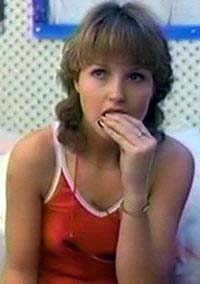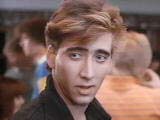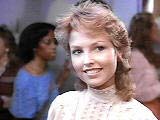 Valley Girl (1983)
Valley Girl (1983)Director: Martha Coolidge
Valley Girl is perhaps best known as the film in which Nicholas Cage had his first starring role. His soulful eyes and sculpted physique burst over teenaged girls and young women like molten rock, a well-formed and permanent memory after cooling. The glare of Cage’s spotlight, however, has thrown the rest of the movie into an unfortunate eclipse. There is so much more to like about this modern, Southern California translation of Romeo & Juliet that is by turns hilarious, sobering, and wise.
Martha Coolidge is a director who has often been tapped for light fare, often directed at teens and starring teen or young adult actors. Valley Girl may be the reason for her career trajectory. Aided by a sharp script and winning, intelligent actors, Coolidge turns this confection into an affecting portrait of the timelessness of teen life and young love set in a dead-on satire of California culture in the 80s.
The film opens with the prototype of the device that Julia Roberts popularized in Pretty Woman (1990)—the shopping montage. Julie (Deborah Foreman), the leader of the popular girls, is shopping with her best friends
 at a mall in the San Fernando Valley, picking through plastic bracelets and mugging with kicky shoes and cotton jersey tops in the store aisles. When the movie starts in earnest, they are gathered in the food court with their acquisitions, talking about—what else?—boys. Suzi (Michelle Meyrink) is throwing a party to which hunky teen Brad (Tony Markes) is to be the main draw. Julie starts mooning over Brad, and Suzi, Stacey (Heidi Holicker), and Loryn (Elizabeth Daily) complain to her to leave some guys for the rest of them. Julie already is dating the superhot Tommy (Michael Bowen), after all. Julie complains that Tommy takes her for granted, “like I’m an old chair.” “Not cool,” her Valley friends chime in. “I definitely need something new,” Julie muses.
at a mall in the San Fernando Valley, picking through plastic bracelets and mugging with kicky shoes and cotton jersey tops in the store aisles. When the movie starts in earnest, they are gathered in the food court with their acquisitions, talking about—what else?—boys. Suzi (Michelle Meyrink) is throwing a party to which hunky teen Brad (Tony Markes) is to be the main draw. Julie starts mooning over Brad, and Suzi, Stacey (Heidi Holicker), and Loryn (Elizabeth Daily) complain to her to leave some guys for the rest of them. Julie already is dating the superhot Tommy (Michael Bowen), after all. Julie complains that Tommy takes her for granted, “like I’m an old chair.” “Not cool,” her Valley friends chime in. “I definitely need something new,” Julie muses.Julie runs into Tommy going in the opposite direction on the mall escalator. A short argument ensues as Tommy reverses course on the moving staircase. When they both reach solid ground, Julie says, “I’m so totally not in love with you anymore,” and gives Tommy back his ID bracelet. Without wanting to overburden this scene with meaning, the movement on opposite sides of the escalator is one of the careful set-ups Coolidge uses to suggest that Julie’s course is shifting away from the familiar.
We next see the girls on the beach. A lanky lad runs to a small rise and the girls comment on what a hunk he is. Loryn says, “Yeah, he’s my kind of guy.” Stacey says, “They all are!” Loryn replies, a bit defensively, “What’s wrong with that?” She is the most sexually experienced of the friends. Julie dips her sunglasses to look at the boy. Their eyes meet. Later, Loryn is standing in a food line, trying to convince another girl to go to Suzi’s party. When she gives Suzi’s address to the girl, a boy in line leans in closer to hear it. He runs back to the lanky boy, Randy (Nicholas Cage), and tells him they have to go to the party. “I’ve seen the chicks!” enthuses Fred (Cameron Dye). “I don’t want to go to the Valley. I’m not in the mood to go to the Valley,” Randy protests. He’s a punker who goes to Hollywood High, in the city.
Of course, they do crash the party, their punk attire grating against the very straight partygoers. They check out the sushi buffet: “What have you got g
 oing here—a bait shop?” Fred tries to make sm
oing here—a bait shop?” Fred tries to make sm all talk with several girls. He asks Stacey, “How’s your mother?” “She’s dead!” Randy tells Fred he knew the party was going to be a dud—at that very moment, in a scene right out of Franco Zefferelli’s version of Romeo & Juliet, a person steps out of Randy’s field of vision, revealing Julie standing alone in the middle of the room. He approaches her and says he has seen her before. “When?” she asks haughtily. “At the beach.” “That was YOU?” Thus starts this crosscultural romance.
all talk with several girls. He asks Stacey, “How’s your mother?” “She’s dead!” Randy tells Fred he knew the party was going to be a dud—at that very moment, in a scene right out of Franco Zefferelli’s version of Romeo & Juliet, a person steps out of Randy’s field of vision, revealing Julie standing alone in the middle of the room. He approaches her and says he has seen her before. “When?” she asks haughtily. “At the beach.” “That was YOU?” Thus starts this crosscultural romance.The film enjoys playing with the horror of the Valleyspeak teens for the “grody to the max” punks. Julie
 is offended when Randy puts down her music but can’t deny that she feels connected to him at a very deep level. When the pressure builds from her friends to dump Randy, she turns to her father (Frederic Forrest), a flowerchild from the 60s, for advice. She wants to be with Randy, but she doesn’t want to have any problems. “Now there’s the rub,” her father says in a perfect Shakespearean quote. Subtly coaxing her away from the group-think of the Valley, he says, “Let me know when YOU decide.”
is offended when Randy puts down her music but can’t deny that she feels connected to him at a very deep level. When the pressure builds from her friends to dump Randy, she turns to her father (Frederic Forrest), a flowerchild from the 60s, for advice. She wants to be with Randy, but she doesn’t want to have any problems. “Now there’s the rub,” her father says in a perfect Shakespearean quote. Subtly coaxing her away from the group-think of the Valley, he says, “Let me know when YOU decide.”There are a number of well-executed subplots. For example, Loryn is used and abused by Tommy, and we see that her promiscuity masks a deep insecurity. Elizabeth Daily is superb in this part of the naïve/wise teen who eventually understands why Julie rejected Tommy. Suzi finds herself competing for a boy she likes with her widowed stepmother Beth (Lee Purcell). As Skip (David Ensor) circles on his bike in front of Suzi’s house, where he has a sexual rendezvous scheduled with Beth, muttering “this is ridiculous” under his breath, his dilemma is perfectly communicated by the background song “Eaten by the Monster of Love,” an 80s tune by the Sparks. In fact, the entire soundtrack is full of 80s gems that exquisitely capture the mood of the characters, most specifically, “Melt with You,” by the Modern English, that describes the unique world Julie and Randy have made for themselves.
I could go on and on about the many wonderful moments and gags in this beautifully directed, performed, scored, and edited film. Better you should see it yourself. Fer shure. Totally. l


3 Comments:
At 7:38 PM, Anonymous said…
Anonymous said…
Best line? Either:
"No, but your face is."
Or
"No other Val dude can touch me!"
At 7:41 PM, Anonymous said…
Anonymous said…
I guess "No, but your face is" can't really be a best line, because it doesn't mean much without the line that preceded it ("Is this movie in 3-D?"), but still.
At 6:07 PM, Anonymous said…
Anonymous said…
Valley Girl was one of the best teen movies of its time. I remember being somewhat bothered by it then—in the way only an overly serious teen can be—since Nic Cage and his friend were supposed to be punks and they were more like some innocuous parents' idea of what a punk is/does. I don't think the movie quite holds up, but among the junk that was coming out at the time (almost no one else was trying to make a good teen movie then, they were just flashing nudity to get teens to buy tickets) it was a great improvement.
Post a Comment
<< Home